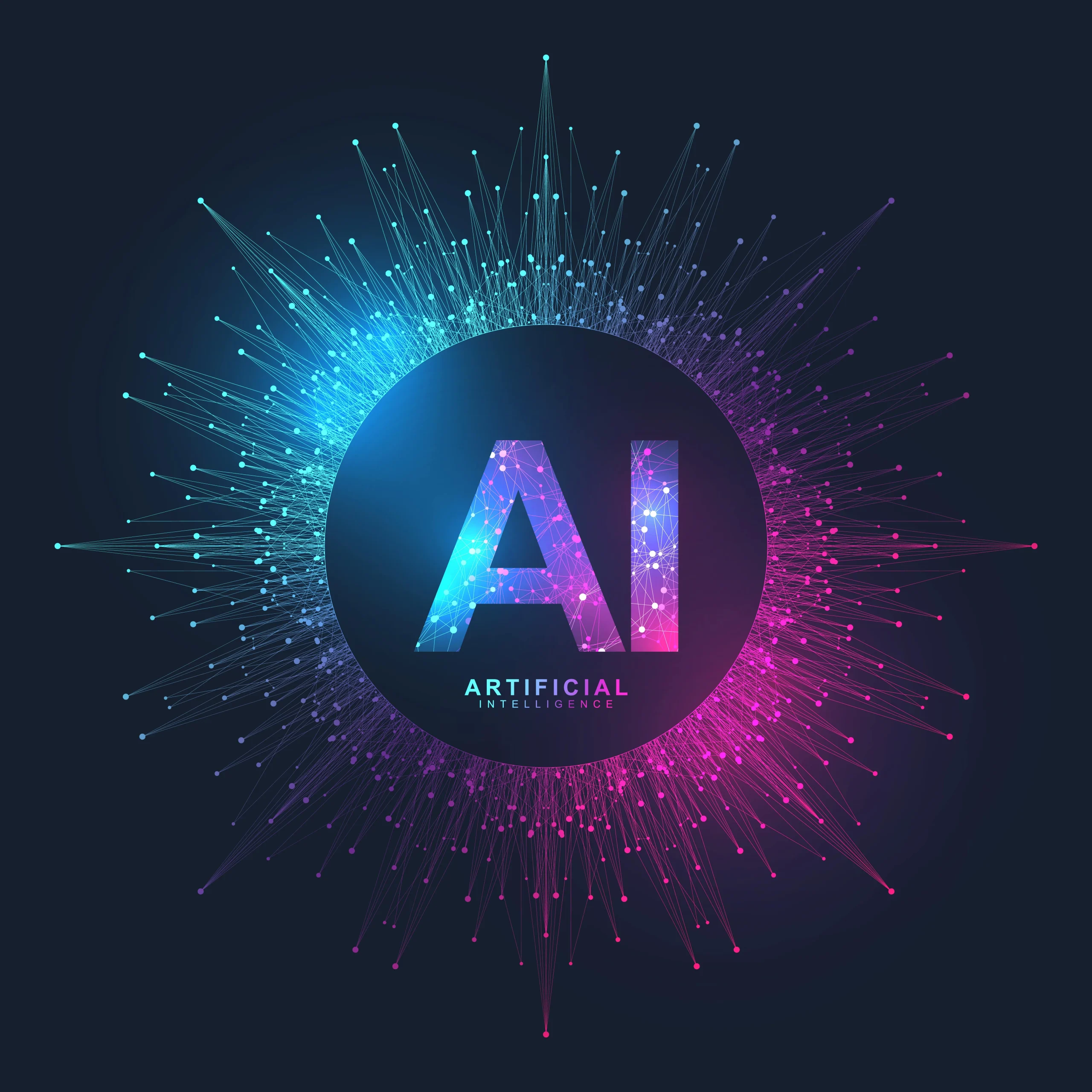Top AI Agent Frameworks: Top 10 List
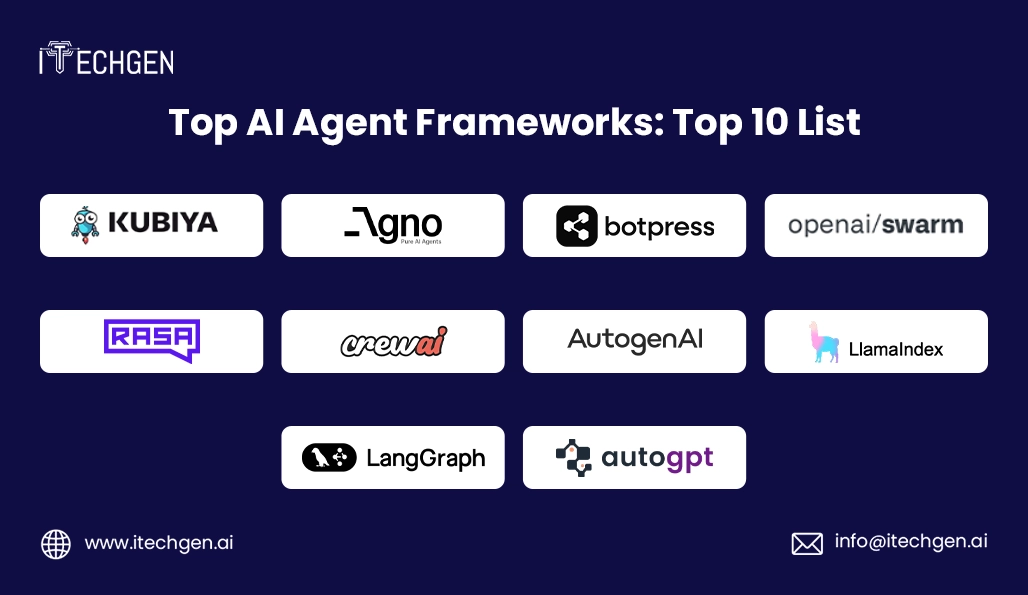
AI agents are like digital assistants that can think, plan, and act on their own. They don’t just respond to commands — they understand goals and take steps to achieve them. From booking travel to handling support tickets, these agents are now helping businesses run smoother and faster.
To build and manage these agents, developers use something called AI agent frameworks. These are tools or platforms that give structure to the process — making it easier to design agents, connect them to data sources, and let them work together as a team. Some frameworks are built for beginners, while others are used by big tech teams handling complex systems.
The adoption is rising fast. According to MarketsandMarkets, the global AI agent market will jump from $7.84 billion in 2025 to $52.62 billion by 2030. (source: marketsandmarkets.com) The reason? More companies want automation that works beyond basic bots — something intelligent, secure, and scalable.
In this blog, we’ve covered the Top AI Agent Frameworks to use in 2025. You’ll learn how each one works, what it’s best for, and how to pick the right fit — whether you want to code from scratch or use drag-and-drop tools. Consider this your shortcut to making smarter automation choices without wasting time on trial and error.
What Are AI Agent Frameworks?
AI agent frameworks are tools that help you build intelligent systems that can act on their own. Think of them as a smart backbone for creating digital agents that handle tasks, make decisions, and even coordinate with other agents. These frameworks allow your agents to delegate work, remember context, collaborate in teams, and use tools like APIs, databases, or large language models to solve real problems — not just reply to questions.
What makes them powerful is their flexibility. Whether you prefer writing code or using no-code interfaces, top AI agent frameworks support both. They also come ready to work with advanced AI models like GPT-4 or Claude, integrate with cloud platforms, vector databases, or even retrieval-augmented generation (RAG) setups. Plus, they offer built-in observability, so you can track what your agents are doing and why.
In short, these frameworks turn complex automation into something anyone — from solo developers to enterprise teams — can manage and scale. And in this blog, we break down the top AI agent frameworks of 2025 so you can pick the right one for your use case without wasting time experimenting.
Top AI Agent Frameworks: A Quick Comparison Table
| Framework | Best Use Case | Key Features | Best For |
| Kubiya | DevOps task automation | Slack-like chat + CLI for agents | Dev teams & ops engineers |
| Agno | Quick no-code agent creation | No-code UI, fast setup, tool integrations | Non-developers & solo founders |
| Botpress | Customer support chatbots | Visual flows, chatbot builder, API support | Product teams & support desks |
| OpenAI Swarm | Team coordination between AI agents | Swarm-style task handling, LLM support | Teams building agent networks |
| RASA | Enterprise-grade NLP bots | Strong NLU, multi-language support | Enterprises & data-heavy apps |
| CrewAI | Multi-agent workflows for teams | Roles, delegation, easy agent teamwork | Startups building task agents |
| AutoGen | Agent research and experiments | Supports GPT & Claude, flexible architecture | Researchers & advanced devs |
| LlamaIndex | Data-driven search and retrieval | Works with vector DBs, document loaders | Anyone needing smart search |
| LangGraph | Graph-based multi-step logic | Node-based flows, error handling, RAG | Builders needing full control |
| AutoGPT | Personal projects & experiments | Auto-goal chasing, minimal setup | Tinkerers & automation fans |
Top AI Agent Frameworks to Explore in 2025
Kubiya
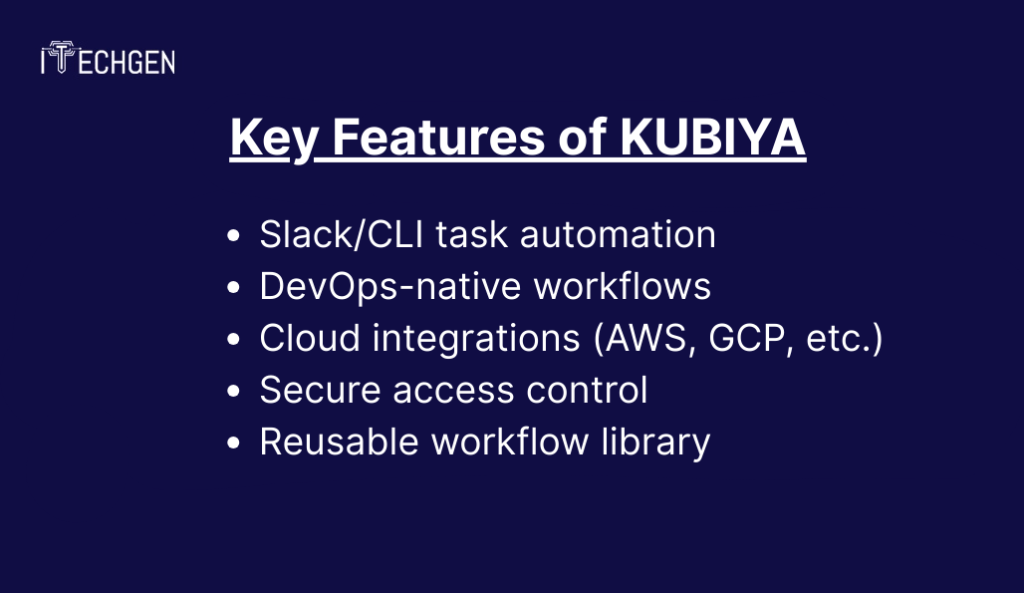
Kubiya stands out among the Top AI Agent Frameworks for DevOps. It lets teams run backend tasks through Slack or CLI. Instead of switching tools, you just chat to deploy, monitor, or troubleshoot. It’s like having an on-call engineer who responds instantly—saving time during critical operations. Kubiya is for tech teams who are tired of hitting walls after building a working prototype. It helps you move from testing to real use—without getting blocked by security checks, user permissions, or setup issues. With Kubiya, you can do DevOps tasks like code deployment, cloud setup, or user access control right inside tools like Slack—no need to switch tabs or open five dashboards. It handles approval flows, roles, and system limits in the background so your work doesn’t get stuck. If your team struggles to ship because of too many handoffs or hidden errors, Kubiya keeps things moving without risking your systems.
Key Features:
- Slack/CLI task automation
- DevOps-native workflows
- Cloud integrations (AWS, GCP, etc.)
- Secure access control
- Reusable workflow library
Supported Languages: Python
Best For: DevOps, Engineers, Product Teams
Popular Use Cases: CI/CD, incident response, cloud cost alerts
Strengths: Chat-based execution, fast setup, infra-specific tools
Limitations:
- Limited to technical use cases
- No visual interface
- Slack/CLI dependence
- Setup required
- Not ideal for business users
Integrations: GitHub, Slack, Terraform, Kubernetes, AWS
Community Support: GitHub, Slack, DevOps Forums
Agno
Agno is one of the most beginner-friendly picks in the Top AI Agent Frameworks. It’s a no-code platform where anyone can build functional agents using drag-and-drop blocks, making it ideal for startups and lean teams. It also offers full developer control through Python, allowing you to scale beyond basic automations.
Working with Agno feels fast and practical. You can plug in APIs like Google Maps, Exa, or DuckDuckGo to make your agents smarter. Each agent can take care of one specific task—like fetching data, handling search queries, or generating itinerary plans. Then, you can group these agents to work together on a shared goal. It’s structured, yet flexible. What stands out is how easily you can connect tools, reuse functions, and add new features without rewriting your whole setup. If you want to build intelligent agents without getting lost in backend chaos, Agno offers a clean and reliable path forward.
Key Features:
- No-code workflow builder
- Multi-agent orchestration
- Tool integration (Zapier-style)
- Human-in-the-loop setup
- Fast deployment
Supported Languages: Python
Best For: Startups, Non-tech Founders, Educators
Popular Use Cases: Lead qualification, support routing, task delegation
Strengths: Fast deployment, beginner-friendly, versatile use cases
Limitations:
- Less backend control
- Limited customization for devs
- Buggy UI at times
- LLM dependency
- Basic design interface
Integrations: OpenAI, Google Sheets, Notion, Zapier, Claude
Community Support: Discord, GitHub, Indie Hacker forums
Botpress
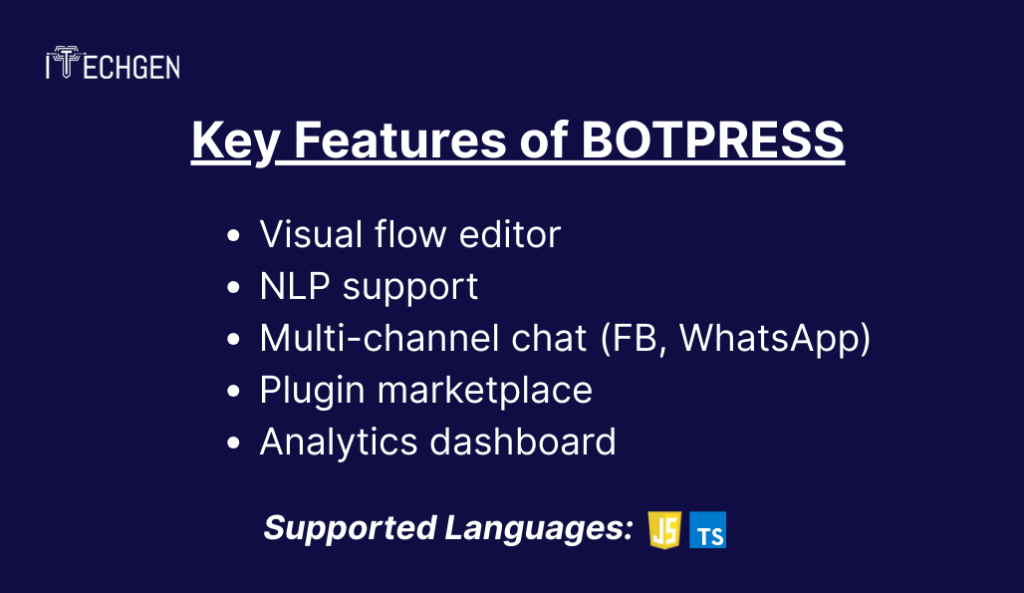
Botpress makes the Top AI Agent Frameworks list for its strong focus on chatbot creation. It’s a visual tool that supports multi-language conversations and connects easily to websites and apps. Many customer support teams use it to reduce ticket volume and build smart helpdesks with minimal developer effort.
Key Features:
- Visual flow editor
- NLP support
- Multi-channel chat (FB, WhatsApp)
- Plugin marketplace
- Analytics dashboard
Supported Languages: JavaScript, TypeScript
Best For: Customer Support, Product Teams, Agencies
Popular Use Cases: FAQ bots, support automation, chatbot MVPs
Strengths: Visual flows, strong NLP, real-time analytics
Limitations:
- Requires scripting for advanced flows
- Limited LLM integrations
- Needs front-end knowledge
- Not ideal for multi-agent setups
- Lacks built-in memory support
Integrations: Dialogflow, WhatsApp, Messenger, REST APIs
Community Support: GitHub, Discord, Stack Overflow
OpenAI Swarm
OpenAI Swarm is one of the newest names in the Top AI Agent Frameworks list. It helps you run multiple AI agents that work together like a team. These agents can share information, divide tasks, and support each other to complete complex workflows. This makes it useful for tasks like customer support routing, research, and system automation.
Using Swarm feels more like an experiment than a finished product. It’s designed for learning how agents interact. For example, it lets one agent decide whether a user request should go to a sales or refund agent. You also get to use features like shared memory and task transfers between agents. But Swarm is still at an early stage. It doesn’t have strong production support, ready-made tools, or a large user base. If you want to understand how agent collaboration works, it’s a good framework to explore. But for real business use, other tools might be more practical for now.
Key Features:
- Multi-agent coordination
- Shared memory across agents
- Role-based task assignment
- LLM support (GPT, Claude)
- Modular architecture
Supported Languages: Python
Best For: Researchers, Analysts, Enterprise Teams
Popular Use Cases: Agent collaboration, internal tooling, task pipelines
Strengths: Coordination focus, scalable logic, memory sharing
Limitations:
- No GUI
- Technical learning curve
- Requires solid backend skills
- Documentation in progress
- Higher infra cost
Integrations: OpenAI, Claude, APIs, data sources
Community Support: GitHub, OpenAI forums, Discord
RASA
RASA is one of the Top AI Agent Frameworks known for its stability, control, and suitability for large organisations. It’s an open-source tool that helps businesses build custom chatbots and virtual assistants with a strong focus on privacy, data security, and language understanding. What sets RASA apart is that it doesn’t rely on third-party servers — your data stays with you, making it a trusted choice in sensitive industries like healthcare, banking, and telecom.
Many companies prefer RASA because it gives them full control over how their bots respond, learn, and improve. You can fine-tune everything — from understanding user intent to managing complex conversations across multiple languages. It also supports on-premise deployment, which means you don’t need to send data to the cloud if you don’t want to. For teams looking for a reliable, production-ready solution that fits strict compliance rules, RASA offers the flexibility and safety most enterprise environments demand.
Key Features:
- Custom intent recognition
- Voice and text support
- Modular pipelines
- Secure data handling
- Multi-language support
Supported Languages: Python
Best For: Enterprises, Fintech, Healthcare
Popular Use Cases: Appointment booking, secure bots, customer service
Strengths: On-prem hosting, security-first, highly customizable
Limitations:
- Steeper learning curve
- Requires model training
- No visual flow builder
- Heavier setup
- Slower initial builds
Integrations: Twilio, Duckling, PostgreSQL, REST APIs
Community Support: GitHub, RASA Forum, Stack Overflow
CrewAI
CrewAI stands out in the Top AI Agent Frameworks for letting you build agent teams that work together like a real crew. Each agent has a clear role—researcher, writer, or analyst—and they pass tasks to one another in a logical order. This makes it perfect for automating multi-step processes like turning YouTube videos into blogs. You define three parts: agents (who does what), tasks (what needs to be done), and tools (what helps them do it). For example, one agent fetches video data, another writes the content—all without manual effort. It’s a great fit for content teams, marketing ops, or internal automation.
Key Features:
- Role-based agents
- Task handoff between agents
- LLM-agnostic
- Fast setup
- Open-source base
Supported Languages: Python
Best For: Tech Teams, SaaS Builders, Automation Projects
Popular Use Cases: Sales follow-ups, scheduling, async projects
Strengths: Team-based design, async support, modular setup
Limitations:
- Early stage project
- No visual dashboard
- Requires Python knowledge
- Documentation gaps
- Needs testing for stability
Integrations: Slack, OpenAI, Zapier, APIs
Community Support: GitHub, Discord, Twitter
AutoGen
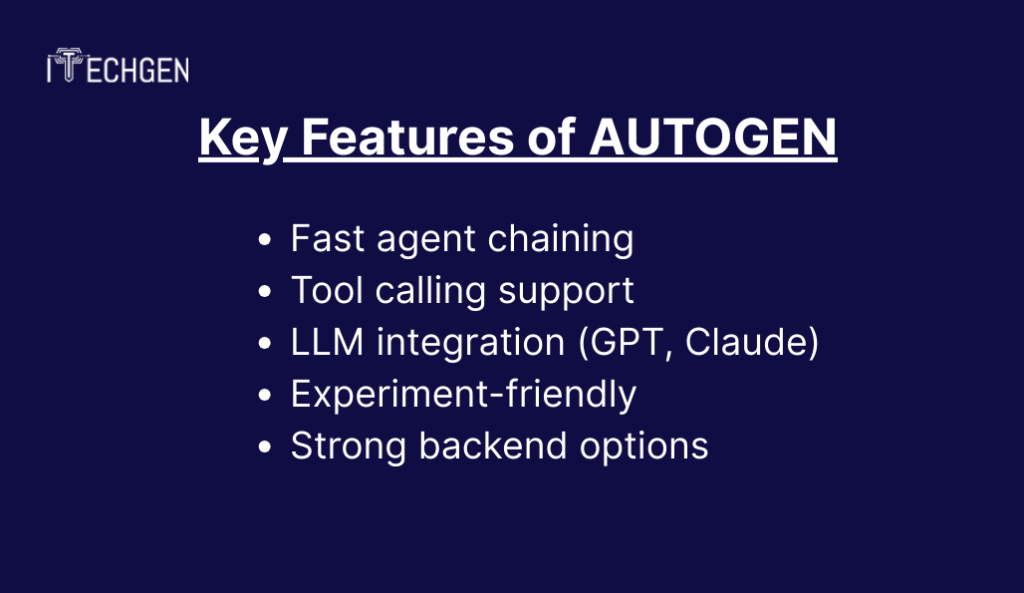
AutoGen sits at the research-heavy end of the Top AI Agent Frameworks. Built by Microsoft Research, it lets developers design agent workflows, connect tools, and test new ideas quickly. Labs, innovation teams, and early adopters use it to experiment with agent behaviors and automation strategies. Think of it as a framework that lets you build AI teams—each agent with a role like developer, reviewer, or project manager—and have them collaborate through natural conversations. It supports human-in-the-loop control, custom tools, and even acts as a drop-in replacement for OpenAI’s API in existing projects. With AutoGen, you’re not just building smarter systems—you’re training autonomous agents to cooperate, iterate, and get better with every task.
Key Features:
- Fast agent chaining
- Tool calling support
- LLM integration (GPT, Claude)
- Experiment-friendly
- Strong backend options
Supported Languages: Python
Best For: AI Labs, R&D Teams, Backend Developers
Popular Use Cases: Model testing, data research, tool orchestration
Strengths: Research-driven, highly flexible, great for chaining tools
Limitations:
- Sparse documentation
- Needs dev expertise
- No visual builder
- Early bugs possible
- May lack templates
Integrations: GitHub, Azure, OpenAI, APIs
Community Support: GitHub, Microsoft Research, Discord
LlamaIndex
LlamaIndex is one of the Top AI Agent Frameworks for data search and document-based bots. It connects your internal data—like PDFs, Notion pages, or databases—to LLMs for smarter question answering. Built in Python and open-source, it acts as a bridge between language models and external data sources, enabling context-rich interactions. Unlike LLMs themselves, LlamaIndex doesn’t generate answers on its own—it helps models find the right info from your data. It’s especially handy for building custom pipelines where ingesting, processing, and querying data is key. While LangChain handles multi-step workflows, LlamaIndex shines in scenarios that require deep integration with documents or APIs. The best part? You can actually use both frameworks together to get the best of orchestration and data retrieval.
Key Features:
- Data indexing layer
- Vector DB support
- Easy API setup
- Format-agnostic (PDFs, CSVs)
- Lightweight deployment
Supported Languages: Python
Best For: Data Teams, Analysts, Researchers
Popular Use Cases: Document search, internal Q&A, contextual bots
Strengths: Smart context use, fast search, flexible integrations
Limitations:
- Needs vector DB knowledge
- No GUI
- API-heavy
- Dev-oriented setup
- Not for live chat use
Integrations: Weaviate, Pinecone, PDFs, Google Drive, HuggingFace
Community Support: GitHub, Discord, Llama community
LangGraph
LangGraph stands out in the Top AI Agent Frameworks for its visual, graph-style setup. It’s ideal when your AI workflows need logic, branching, context, or long-term memory. Unlike simpler tools like LangChain, LangGraph gives developers full control over how agents interact, make decisions, and persist information across stages. It uses nodes and edges to build complex, modular systems—think routers, classifiers, and multi-agent flows. You can assign roles to agents (like emotional vs logical responders), route user queries based on context, and even visualize the entire flow. Thanks to features like conditional edges, structured outputs, and persistent state, LangGraph is a favorite for production-level AI agents. If you’re serious about scaling or fine-tuning multi-agent behavior, this is a tool worth exploring.
Key Features:
- Node-based flow control
- Memory and state support
- Error handling
- Full tool integration
- Open developer ecosystem
Supported Languages: Python
Best For: Developers, Engineers, Technical Builders
Popular Use Cases: Complex workflows, multi-agent RAG, internal tools
Strengths: Clear logic, error tracing, composable design
Limitations:
- Python-only
- Learning curve for non-devs
- No GUI
- Early-stage tooling
- Needs LangChain knowledge
Integrations: LangChain, APIs, Vector DBs, Cloud functions
Community Support: GitHub, Discord, LangChain Users
AutoGPT
AutoGPT stands out among the Top AI Agent Frameworks for its ability to run fully autonomous workflows without constant human input. It works by letting you define a goal—such as researching a topic or summarizing content—and then breaking that goal into smaller steps, executing them one by one. What makes AutoGPT unique is its ability to access the internet, fetch live data, and even collaborate with other agents to handle more complex tasks. It also supports file management, plugin integration, and memory storage, making it suitable for tasks like SEO research, content generation, and automated reporting. While it’s popular among solo developers and automation teams, it does have its limits—it may struggle with highly complex decisions, and continuous usage can lead to high API costs. Still, if you’re looking for a framework that thinks ahead, adapts on its own, and completes tasks from start to finish, AutoGPT is a solid choice.
Key Features:
- Goal-driven agent
- Simple CLI setup
- Minimal config required
- Fully open source
- Community-driven
Supported Languages: Python
Best For: Hobbyists, Developers, Side Projects
Popular Use Cases: Market research, email writing, personal tasks
Strengths: Fast to try, community support, minimal code needed
Limitations:
- Unstable at times
- Limited memory
- Poor error recovery
- Needs active monitoring
- Prompt chaining can break
Integrations: APIs, CLI tools, Browser plugins
Community Support: GitHub, Reddit, Discord
Where AI Agent Frameworks Are Headed in 2025 and Beyond
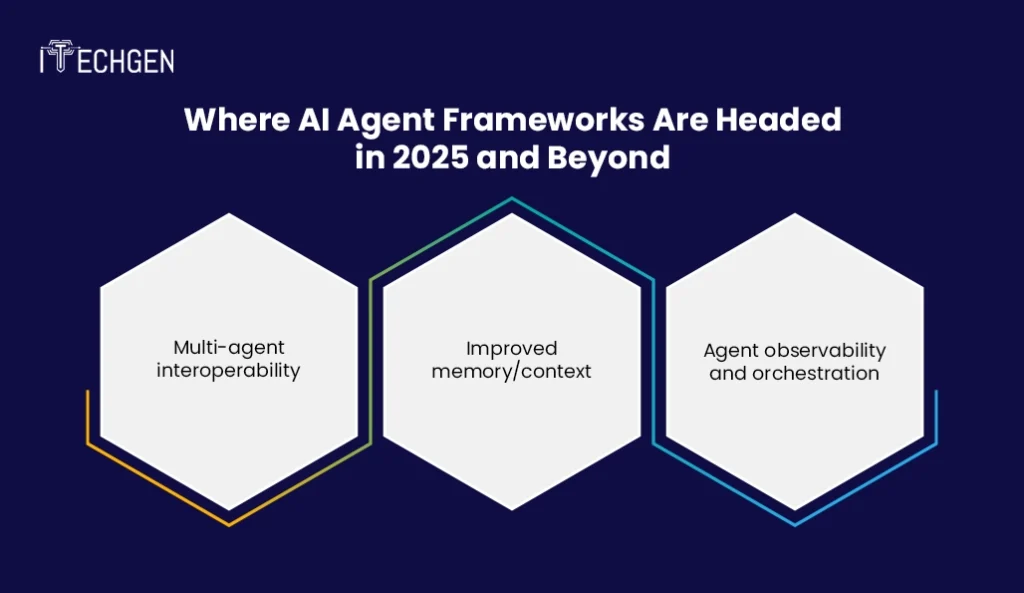
AI agent frameworks are evolving fast. In 2025, it’s no longer just about automating a single task—it’s about building smart, connected systems that can handle complex workflows, share context, and improve over time. Businesses now expect agents to work as a team, stay aware of the full picture, and adapt without constant rewiring.
Here’s where the top AI agent frameworks are headed:
- Multi-Agent Interoperability: Agents will work in groups—qualifying leads, sending proposals, booking meetings. Platforms like CrewAI and Swarm already support this. What’s next? Cross-platform teamwork with zero manual integrations.
- Improved Memory and Context Handling: No more forgotten tasks or repeated prompts. Tools like LangGraph and AutoGen help agents retain user info, task history, and previous outcomes for smarter, more reliable actions.
- Observability and Orchestration: Developers need visibility. New frameworks offer dashboards, logs, and step tracking so you can catch bugs, retrain agents, and optimize performance without starting from scratch.
Conclusion
Picking from the top AI agent frameworks is no longer just about tech—it’s about working smarter. These tools help teams handle routine tasks, respond to customers faster, and streamline daily operations without hiring more people. If you’re looking for something quick and easy, no-code tools like Agno work great for customer support. For smart data search or internal chatbots, LlamaIndex connects your files and databases to AI models. And if you’re in research or need more custom workflows, AutoGen by Microsoft lets you build agent systems that can collaborate, run code, and even fix errors on their own. No matter your use case—automation, support, or internal operations—choosing the right tool from the top AI agent frameworks today can help you save time, cut manual work, and grow faster in the long run.

Pankaj Arora (Founder & CEO)
Pankaj Arora is the Founder & CEO of iTechGen, a visionary leader with a deep passion for AI and technology. With extensive industry experience, he shares expert insights through his blogs, helping businesses harness the power of AI to drive innovation and success. Committed to delivering customer-first solutions, Pankaj emphasizes quality and real-world impact in all his endeavors. When not leading iTechGen, he explores emerging technologies and inspires others with his thought leadership. Follow his blogs for actionable strategies to accelerate your digital transformation and business growth.
View More About Pankaj Arora
